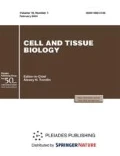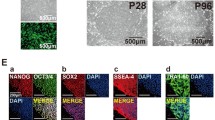Abstract
Ataxia telangiectasia (AT) is a genetic disorder caused by the mutation of the atm gene. It is characterized by progressive neurological abnormalities in combination with oculocutaneous telangiectasias, immunodeficiency, and increased frequency of malignancy. Cells of AT patients display increased radiosensitivity and premature aging markers, including shortened telomer length beginning at birth and limited proliferation potential. We studied radiosensitivity (at a dose 2 Gy) and the manifestation of premature aging markers in cultured skin fibroblasts derived from two unrelated AT patients and their heterozygous parents. We have shown that all the markers studied, i.e., HP1-γ, histone H2AX phosphorylated for serine-139 (γ-H2AX) and foci of 53BP1 protein, indicate the premature aging of the cells of both patients and their blood relatives. However, cells of heterozygous carriers express premature aging to a lesser extent. A study of the repair process (the amount of γ-H2AX and the number of cells with 53BP1 foci in their nuclei) after X-ray irradiation showed that patients’ cells only halfway completed repairs, even 24 h after irradiation, while the healthy donor cells completed repairs in 24 h. In cells from atm heterozygous donors, DNA repair was also slower. Heterozygous cells also differ reliably from healthy donor cells. Only amounts of p21Waf1/Cip1 protein, an inhibitor of cyclin-dependent kinases, in heterozygous cells do not differ from normal cells. However, the patients’ cells differ significantly. It was found that the mutation of the atm gene was related to the suppression of the reparation of DNA double-strand breaks (DSBs), which is in good agreement with increased radiosensitivity and premature aging in AT families at the cellular level.
Similar content being viewed by others
References
Arlett, C.F. and Priestley, A., An Assessment of the Radiosensitivity of Ataxiatelangiectasia Heterozygotes, Kroc. Found. Ser., 1995, vol. 19, pp. 101–109.
Ayoub, N., Jeyasekharan, A.D., Bernal, J.A., and Venkitaraman, A.R., HP1-beta Mobilization Promotes Chromatin Changes That Initiate the DNA Damage Response, Nature, 2008, vol. 453, pp. 682–686.
Concannon, P., ATM Heterozygosity and Cancer Risk, Nat. Genet., 2002, vol. 32, pp. 89–90.
Eliezer, Y., Argaman, L., Rhie, A., Doherty, A.J, and Goldberg, M., The Direct Interaction between 53BP1 and MDC1 Is Required for the Recruitment of 53PB1 to Sites of Damage, J. Biol. Chem., 2009, vol. 284, pp. 426–435.
Goodarzi, A.A., Noon, A.T., Deckbar, D., Ziv, Y., Shiloh, Y., Löbrich, M., and Jeggo, P.A., ATM Signaling Facilitates Repair of DNA Double-Strand Breaks Associated with Heterochromatin, Mol. Cell., 2008, vol. 31, pp. 167–177.
Hao, L.Y., Strong, M.A., and Greider, C.W., Phosphorylation of H2AX at Short Telomeres in T Cells and Fibroblasts, J. Biol. Chem., 2004, vol. 279, pp. 45148–45154.
Hill, R., Bodzak, E., Blough, M.D., and Lee, P.W., P53 Binding to the p21 Promoter Is Dependent on the Nature of DNA Damage, Cell Cycle, 2008, vol. 7, pp. 2535–2543.
Iwabuchi, K., Matsui, T., Hashimoto, M., Matsumoto, Y., Kurihara, T., and Date, T., Characterization of a Cancer Cell Line That Expresses a Splicing Variant Form of 53BP1: Separation of Checkpoint and Repair Functions in 53BP1, Biochem. Biophys. Res. Commun., 2008, vol. 376, pp. 509–513.
Karlsson, K.H. and Stenerlow, B., Focus Formation of DNA Repair Proteins in Normal and Repair-Deficient Cells Irradiated with High-LET Ions, Radiat. Res., 2004, vol. 161, pp. 517–527.
Kolman, A., Spivak, I., Naslund, M., Dusinska, M., and Cedervall, B., Propylene Oxide and Epichlorohydrin Induce DNA Strand Breaks in Human Diploid Fibroblasts, Environ. Mol. Mutagen., 1997, vol. 30, pp. 40–46.
Kopnin, B.P., Targets of Oncogenes and Tumor Suppressors: Key for Understaanding Basic Mechanisms of Carcinogenesis, Biokhimiya, 2000, vol. 65, no. 1, pp. 5–33.
Kuo, L.J. and Yang, L.X., Gamma-H2AX—A Novel Biomarker for DNA Doublestrand Breaks, In Vivo, 2008, vol. 22, pp. 305–309.
Lavin, M.F., Ataxia-Telangiectasia: From a Rare Disorder to a Paradigm for Cell Signalling and Cancer, Nat. Rev. Mol. Cell Biol., 2008, vol. 9, pp. 759–769.
Lee, H., Kwak, H., Cho, I.T., Park, S.H., and Lee, C.H., S1219 Residue of 53BP1 Is Phosphorylated by ATM Kinase upon DNA Damage and Required for Proper Execution of DNA Damage Response, Biochem. Biophys. Res. Commun., 2008, vol. 378, pp. 32–36.
Nygren, J., Cedervall, B., Ericksson, M., Dusinska, M., and Kolman, A., Induction of DNA Strand Breaks by Ethylene Oxide in Human Diploid Fibroblasts, Envir. Mol. Mutagen., 1994, vol. 24, pp. 161–167.
Pletjushkina, O.Y., Fetisova, E.K., Lyamzaev, K.G., Ivanova, O.Y., Domnina, L.V., Vyssokikh, M.Y., Pustovidko, A.V., Alexeevski, A.V., Alexeevski, D.A., Vasiliev, J.M., Murphy, M.P., Chernyak, B.V., and Skulachev, V.P., Hydrogen Peroxide Produced Inside Mitochondria Takes Part in Cell-to-Cell Transmission of Apoptotic Signal, Biokhimiya, 2006, vol. 71, no. 1, pp. 75–84.
Radhakrishnan, S.K., Gierut, J., and Gartel, A.L., Multiple Alternate p21 Transcripts Are Regulated by p53 in Human Cells, Oncogene, 2006, vol. 25, pp. 1812–1815.
Scaffidi, P. and Misteli, T., Lamin A-Dependent Nuclear Defects in Human Aging, Science, 2006, vol. 312, pp. 1059–1063.
Sedelnikova, O.A., Horikawa, I., Zimonjic, D.B., Popescu, N.C., Boner, W.M., and Barrett, J.C., Senescing Human Cells and Aging Mice Accumulate DNA Lesions with Unrepairable Double-Strand Breaks, Nat. Cell Biol., 2004, vol. 6, pp. 168–170.
Shi, Q., Wang, X., and Ren, J., Biophysical Characterization of the Interaction of p21 with Calmodulin: A Mechanistic Study, Biophys. Chem., 2008, vol. 138, pp. 138–143.
Shiloh, Y., ATM and Related Protein Kinases: Safeguarding Genome Integrity, Nature Rev., 2003, vol. 3, pp. 155–168.
Smirnova, N.V., Spivak, I.M., Pleskach, N.M., and Mikhel'son, V.M., The Atypical Case of Werner Syndrome: Effect of Laminopathy, Tsitologiia, 2008b, vol. 50, no. 9, pp. 780–788.
Smirnova, N.V., Spivak, I.M., Pleskach, N.M., Zherebtsov, S.V., Aksenov, N.L., and Mikhel'son, V.M., An Atypical Case of Werner Syndrome: Epigenetic Control and DNA Damage Response Alterations, Tsitologiia, 2008a, vol. 50, no. 10, pp. 868–877.
Spivak, I.M., Hereditary Diseases with Primary and Secondary DNA Repair Defects, Tsitologiia, 1999, vol. 41, no. 5, pp. 338–380.
Spivak, I.M., Smirnova, N.V., Pleskach, N.M., Ledashcheva, T.A., and Mikhel'son, V.M, Characteristics of p53 Protein Stabilization in Cells of Patients with Ataxia-Telangiectasia after gamma-Irradiation, Tsitologiia, 2005, vol. 47, no. 10, pp. 898–906.
Stiff, T., O'Driscoll, M., Rief, N., Iwabuchi, K., Lobrich, M., and Jeggo, P.A., ATM and DNA-PK Function Redundantly to Phosphorylate H2AX after Exposure to Ionizing Radiation, Cancer Res., 2004, vol. 64, pp. 2390–2396.
Takahashi, A. and Ohnishi, T., Does gammaH2AX Foci Formation Depend on the Presence of DNA Double Strand Breaks?, Cancer Lett., 2005, vol. 229, pp. 171–179.
Tanaka, T., Halicka, H.D., Huang, X., Traganos, F., and Darzynkiewich, Z., Constitutive Histone H2AX Phosphorylation and ATM Activation, the Reporters of DNA Damage by Endogenous Oxidants, Cell Cycle, 2006, vol. 5, pp. 1940–1945.
Wilson, K.A. and Stern, D.F., NFBD1/MDC1, 53BP1 and BRCA1 Have Both Redundant and Unique Roles in the ATM Pathway, Cell Cycle, 2008, vol. 7, pp. 3584–3594.
Zhou, S., Greenberger, J.S., Epperly, M.W., Goff, J.P., Adler, C., Leboff, M.S., and Glowacki, J., Age-Related Intrinsic Changes in Human Bone-Marrow-Derived Mesenhymal Stem Cells and Their Differentiation to Osteoblasts, Aging Cell., 2008, vol. 7, pp. 335–343.
Author information
Authors and Affiliations
Corresponding author
Additional information
Original Russian Text © E.A. Polubotko, N.V. Smirnova, N.M. Pleskach, V.M. Mikhelson, I.M. Spivak, 2009, published in Tsitologiya, Vol. 51, No. 8, 2009, pp. 712–718.
Rights and permissions
About this article
Cite this article
Polubotko, E.A., Smirnova, N.V., Pleskach, N.M. et al. Premature aging syndrome in ataxia telangiectasia patients. Cell Tiss. Biol. 3, 491–496 (2009). https://doi.org/10.1134/S1990519X09050125
Received:
Published:
Issue Date:
DOI: https://doi.org/10.1134/S1990519X09050125




